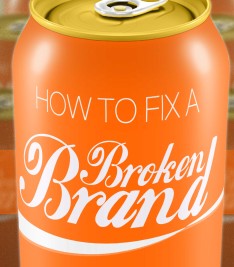How to fix a broken brand
 From grounded planes to faulty phone networks and bad tasting beverages, in a feature that first appeared in Encore, Matt Smith looks at how to fix a broken brand.
From grounded planes to faulty phone networks and bad tasting beverages, in a feature that first appeared in Encore, Matt Smith looks at how to fix a broken brand.
It takes a bold marketer to admit their brand is broken and yet the advertising landscape is littered with examples where they have done just that.
In 2011 Mother Energy Drink released a commercial created by creative agency McCann that owned up to a major flaw with its product. “At Mother Energy Drinks we don’t do things by half measures. And when we heard people didn’t like the taste of old Mother we said ‘You’re right’ and created a completely new Mother,” an actor decked out in commando gear announces in the opening shot of the spot. “We then set about hunting down those responsible for old Mother.”
It’s not a new solution to face up to criticism, make a change, and then try to put a spin on the story. Advertisers have been using the tactic since as far back as the 1960s when a US campaign for Avis car rentals admitted it was number two in its market. The acknowledgement of perceived failure helped the brand to gain ground up against the number one player, Hertz.
More recently, in 2010 a US Dominos Pizza ad featured staff reading out criticism that its pizza crust tasted like cardboard.
Annie Price, creative director at McCann says: “If a brand is a little bit broken sometimes the best approach is the honest truth. You try with every client to build that relationship. McCann tried to be honest with the Mother ad instead of beating our chest in victory over the brand listening to the consumers. The idea was to handle the backlash with cleverness and creativity.”
It was a gamble that paid off. Not only is Mother still alive and kicking, McCann still has the account.
But perhaps the greatest recent example of a brand admitting outright that it has a problem is Vodafone. In recent years the telco has come to be known as the least reliable mobile network in Australia peaking in 2011 with the ‘Vodafail’ fiasco when a surge in demand led to a massive network crash. The telco reportedly lost around 1.5 million customers in two years and the effects of the backlash are still evident today.
Kim Clarke, chief marketing officer of Vodafone Australia, says: “We spent two years working to address what we saw as our core criticisms. Phone reception was one of them. We’ve now increased network coverage by 40 per cent. The other thing we addressed was our engagement with customers.”
Vodafone embarked on an aggressive marketing campaign to rebuild its struggling brand. Working with creative agency Ogilvy, a series of self-deprecating commercials were released. One compared the network to a broken down Datsun, another had characters commiserating their friend’s bad fortune upon signing up with the telco only to be treated to a sermon about the new ‘network confidence guarantee’. “When you’re having an issue with a relationship you have two options,” says Clarke. “You can hide away in the corner or meet it head on. We decided to engage directly with the customers. After that you can move on and build a new discussion.”
Vodafone’s approach looks to be working for the brand.
“So far the response to our campaign has been good, which isn’t to say that it couldn’t be better,” says Clarke. “We need to keep delivering a good core promise, and make sure we actually deliver better plans and services on top of that. There isn’t just one silver bullet.”
And the conversation has moved on quickly for the telco. The first of the ads admitting to a poor brand image was released in April while the latest commercial launched the ‘Kidult’ campaign, which sees children’s heads grafted onto adult bodies. Released last month, the ad appeals to the inner child in customers.
Brand expert Patrick Guerrera, managing director of Re, the brand consultancy business of M&C Saatchi group, praises the strategy. He says: “They’ve fallen behind due to competitive threat, but what they’re doing is absolutely right – acknowledging issues, fixing them. Now to survive they’ll have to really come back spinning.”
While Guerrera himself didn’t work on the brand, M&C Saatchi held the Vodafone account in the late ’90s before the telco’s troubles set in. Guerrera calls the current campaign a massive repair job and says that while it is not impossible, it is difficult to break a brand as big as Vodafone. He says: “The big mistake is when the brand is stretched to the point where it’s unbelievable. It’s a recipe for disaster. If you’ve created a fucking huge promise and you can’t deliver, the customers are going to walk away.”
Dan Ilic, executive producer of Downwind Media, a company well versed in creating brave and at times controversial commercials, agrees that Vodafone has done the right thing acknowledging the poor perception of its brand while doing something to fix it. He says: “Vodafone has sunk heaps of money into their network. The ‘New Vodafone’ campaign is a great way to show people you’ve changed and ask them to please come back. But it is a bit like a junkie gone through rehab that is ready to play with you again.”
Ilic believes that the way to salvaging a broken brand is a warts-and-all approach to the truth. “A lot of advertising is lying to the consumer, so why not flip it and make it truthful?” he says. “People are constantly being sold to, and brands are constantly inflating themselves to the audience. The audience find honesty refreshing and will lap it up.”
But while addressing a flaw in your service offering is one thing, trying to recover your brand’s image after being grounded by the Civil Aviation Safety Authority is on another level entirely. In 2011 the Tigerairways Australia fleet was grounded and the brand tainted by serious safety concerns. When the airline was granted permission to return to the skies, a rebrand was a logical step.
In July this year, the airline changed its name to Tigerair.
Carly Brear, commercial director for Tigerair, says the change is more than just a fresh coat of paint. She says: “We should never forget the grounding happened, and the minute we become complacent is the minute we forget the lessons. If the brand change was just about that then it would be misguided. But after five years in Australia and the recent joint venture with Virgin Air it was really time to make the change.”
Brear admits there is still much to do to rebuild consumer confidence with the brand. She says: “Getting our customers to where they want to go on time, safely and offering excellent customer service at great value fares is the key. It’s not just changing a look, we have to perform as well.”
McCann handles advertising for Tigerair and the agency’s CD Price says: “You need to make potential negatives work for you and turn it around. Tigerair is about flights for everyone, not just the elite. But it needs to show honesty. I think people appreciate the truth.”
M&C Saatchi’s Guerrera is critical of Tigerair’s effort to communicate change. “A new logo is all funky and great, but I don’t know what it means to me as a consumer. It’s just lipstick on a gorilla,” he says.
“The reputation drives consideration, brand and conception. So how is some lipgloss ultimately going to change how they operate?”
It seems that marketers attempting to rebuild a brand usually succeed using the approach of brutal honesty – and Ilic says a healthy sense of humour can also help.
“Self-deprecating is a really big part of Australian society, but it’s rare that brands ever try and make fun of themselves because of the heinous amounts of money involved,” he says. “But sometimes that’s the exact medicine you need. Be really truthful with the market, and customers will appreciate it. Once you’ve owned up to your mistakes then you can move on.”
Guerrera says the key lies in brands keeping promises. He says: “To come back, it takes a lot of money, immense courage and a complete rethinking of business. Deliver your promise then prove you can do it.”
 This feature first appeared in Encore. Download it now on iPad, iPhone and Android tablet devices.
This feature first appeared in Encore. Download it now on iPad, iPhone and Android tablet devices.


Maybe the Board and Management at the Ten Network should read this.
Yes – we have “broken our brand” and we are sorry.